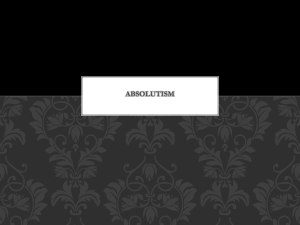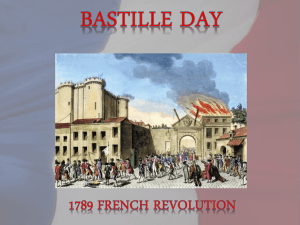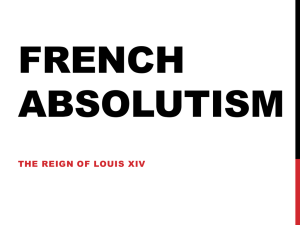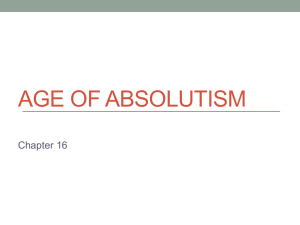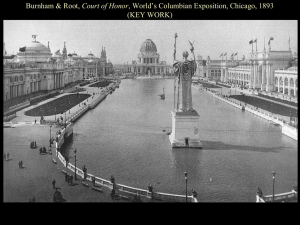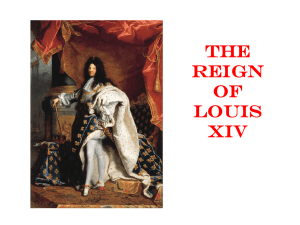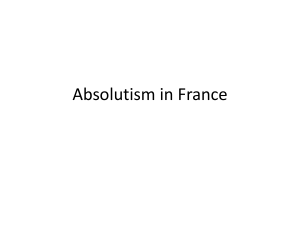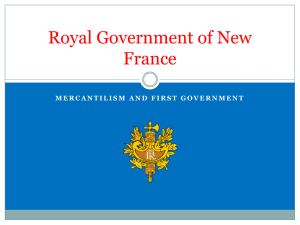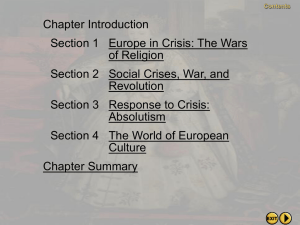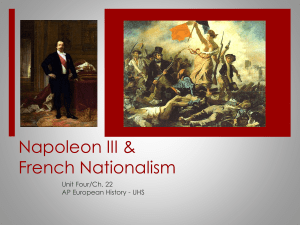unit #3 absolute monarchy in france
advertisement
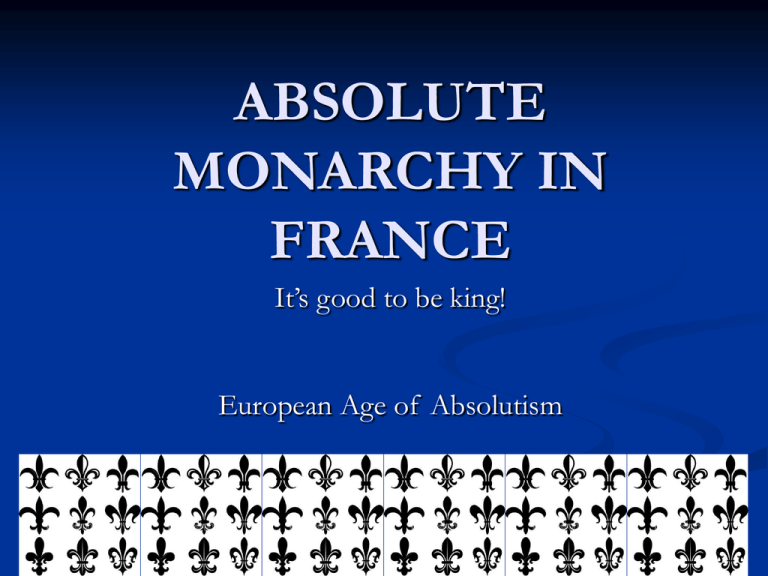
ABSOLUTE MONARCHY IN FRANCE It’s good to be king! European Age of Absolutism ABSOLUTISM 1648-1763): Period of the growth of absolute monarchies in Spain, France, Austria, Russia, and Prussia. A. Sovereignty No rival armies within the state No rival courts of law within the state B. TYPES OF government 1. Absolute Monarchy: France, Spain, Russia; sovereignty lies in the person of the ruler - rule by Divine Right – the power to rule comes from God 2. Constitutional State: Great Britain Netherlands BOURBON DYNASTY HENRY IV A. Begun by Henry IV (1589-1610): Le bon roi Henri'' (good King Henry Emblem of the Bourbons - fleurs-de-lis; married Marie d'Medici (2nd wife) 1. Accomplishments: Restored order, trade, and industry following the religious wars; famous quote - A chicken in every pot - shows concern for his people; 1598 Edict of Nantes granted freedom of worship and other civil rights to the Huguenots. BOURBON DYNASTY HENRY IV 2. Duc de Sully: Chief Minister to Henry IV; together they a. lowered taxes on the peasants b. revived the paulette - an annual tax on people who had purchased judicial and financial offices c. reduced the royal debt and built up the treasury (through reliance on sale of government offices) d. promoted overseas trade by giving subsidies to trading companies; colonization begun in Canada e. began national highway system f. introduced silk culture to France BOURBON DYNASTY HENRY IV B. By the seventeenth century France was the most populous country in Europe C. Death of Henry IV: murdered by Francois Ravaillac, a Catholic fanatic on May 14, 1610. BOURBON DYNASTY LOUIS XIII Louis XIII (1610-1643): Nine years old at the time of the death of his father, Henry IV. Louis XIII did not develop the confidence necessary to rule on his own. His mother Marie de'Medici served as regent until 1617. A. Anne of Austria: Louis XIII married this daughter of the Spanish king Philip III, in 1615 but ignored her for most of the time. She dallied with the Duke of Buckingham (woven into Dumas' The Three Musketeers) BOURBON DYNASTY LOUIS XIII B. Cardinal Richelieu: Louis would show sporadic ruling abilities and displayed courage on the battlefield against a Huguenot rebellion in 1622, but his mental instability and chronic ill health would undermine his ability for sustained effort. In 1624 Marie de'Medici, appointed Cardinal Richelieu to the Council of Ministers. In 1628 Richelieu became the chief minister. This advisor to Louis XIII held the real power BOURBON DYNASTY LOUIS XIII/RICHELIEU 1. Raison d'etat: Reason of State - what is done for the state is done for God justification for actions 2. Abolished fortified castles and fortified Protestant towns to reduce the power of the nobility; 1628 captured Huguenot rebel stronghold of La Rochelle 3. Reorganized the government bureaucracy: 32 generalities or districts each with an intendant responsible to the monarchy 4. Established French academy for the standardization of the French language in 1635 5. supported the enemies of the Hapsburgs to thwart Hapsburg territorial ambitions by supporting Protestants in the Swedish phase of the Thirty Years War 1631 6. 1640 new coinage introduced: new gold coin the Louis and new silver coin, the Ecu C. The End: Richelieu died in December, 1642: Louis XIII died 5 months later of tuberculosis. BOURBON DYNASTY LOUIS XIV LOUIS XIV (1638-1715): King of France from 1643 until 1715 (72 years). He had the longest reign in European history. During this time he brought absolute monarchy to its height. THE MINORITY OF LOUIS XIV (1643-1661) A. Parents: Louis XIII and Anne of Austria (Hapsburg - daughter of Philip III of Spain). He was their first child after a marriage of 23 years (married in 1615). They considered him ''god-given''. He succeeded his father on the throne at the age of five BOURBON DYNASTY LOUIS XIV B. The REGENCY: Anne served as regent for her son. She relied on Richelieu's successor, Cardinal Mazarin. Rumor hath that their relationship was very close; he might have been her secret spouse. BOURBON DYNASTY LOUIS XIV C. The Fronde ''slingshot'' - rebels as naughty children (1648-53): The great nobles and the judges of the Parlement of Paris launched major but uncoordinated revolt in reaction to the centralizing policies of Richelieu and Mazarin. Louis was ten years old when the revolt began. There were riots in Paris and the countryside. The royal family was twice driven out of Paris and when Louis was 13 he and Anne were held under virtual arrest in the royal palace in Paris. This was a frightening experience for the boy and resulted in his dislike of Paris. Mazarin finally suppressed the Fronde and restored internal order. The tax exempt status was re-affirmed but the French economy had been disrupted during the rebellion. BOURBON DYNASTY LOUIS XIV D. FRANCE BECOMES LEADING POWER IN EUROPE: The Peace of Westphalia (1648) which ended the Thirty Years' War, together with the Peace of the Pyrenees (1659), which concluded prolonged warfare with Spain, made France the leading European power. E. Marriage: The latter treaty was sealed by Louis XIV's marriage on June 9, 1660 to Marie Therese (1638-83), the daughter of Philip IV of Spain and sister of Charles II. They had seven children but only one survived to adulthood. BOURBON DYNASTY LOUIS XIV LOUIS XIV takes CONTROL A. END OF THE CHIEF MINISTERS: On Mazarin's death in 1661, Louis astounded his court by becoming his own chief minister, thereby ending the long ''reign of the cardinal-ministers.'‘ B. LOUIS IN Charge: The king controlled his own government until his death, acting through his high state council (conseil d'en haut) and a few select ministers, whom he called or dismissed at will. Breaking with tradition, Louis excluded from his council members of his immediate family, great princes, and others of the old military nobility (noblesse d'epee); his reliance on the newer judicial nobility (noblesse de robe) led the duc de SaintSimone to call this, mistakenly, ''the reign of the lowborn-bourgeoisie BOURBON DYNASTY LOUIS XIV A. THE GOOD YEARS (1661-1683) ADMINISTRATION 1. National Government: The parlements lost their traditional power to obstruct legislation; the judicial structure was reformed by the codes of civil procedure (1667) and criminal procedure (1669), although the overlapping and confusing laws were left untouched. 2. Local Government: increasingly placed under removable intendants - responsible directly to the king. 3. City Government: Urban law enforcement was improved by creation (1667) of the office of lieutenant general of police for Paris, later imitated in other towns. BOURBON DYNASTY LOUIS XIV B. Finance: Jean Baptiste Colbert served as Minister of Finance from 1665-1683. He sponsored several programs which increased the wealth and prosperity of France. He adhered to the economic policy of mercantilism, an economic theory which said a country's economic strength rested upon acquiring gold and silver, expanding manufacturing, encouraging commerce, owning colonies, building up shipping and the navy, and a favorable balance of trade. To accomplish these things Colbert used tight control over standards of quality, government subsidies and a high protective tariff. He eliminated internal trade barriers. He was not able to solve the basic problem of tax inequities. BOURBON DYNASTY LOUIS XIV -MERCANTILISM 1) expanded manufacturing, particularly glassmaking, weaving, and silk production, by granting subsidies and tax benefits to French companies 2) developed mining and agriculture 3) encouraged skilled workers from other countries to settle in France. 4) established protective tariff. 5) encouraged people to migrate to Canada for the fur trade. 6) encouraged the building of roads and canals. 7) added 100 warships to French navy BOURBON DYNASTY LOUIS XIV – The Arts C.The Arts" Colbert and the king shared the idea of glorifying the monarch and monarchy through the arts. Louis was a discriminating patron of the great literary and artistic figures of France's classical age. Louis established or developed in rapid succession academies for painting and sculpture (1663), inscriptions (1663), French artists at Rome (16661: and science (1666), followed by the Paris Observatory (1667) and the academies of architecture (1671) and music (1672). The literary Academia Francaise also came under formal royal control in 1671. France set the cultured standards for all of Europe. BOURBON DYNASTY LOUIS XIV – the Arts 1. Jean Baptiste (Poquelin) Moliere (1622-1673): Comic dramatist; actor, director, playwright. He was the official provider of entertainment to the king. The French national theater, the Comedie Francaise, has been known as the House of Moliere. His works include The School for Husbands (1661), The School for Wives (1662), Tartuffe (1564), Don Juan (1665), The Misanthrope (1666) 2 . Pierre Corneille: French writer of tragic plays; modeled works on plays of Aeschylus and Sophocles. These plays had emphasized the classical unities, ie. single action, single locale, single day BOURBON DYNASTY LOUIS XIV – the Arts 3 . Jean Baptiste Racine: French writer of tragic plays; modeled works on plays of Aeschylus and Sophocles 4 . Jean Baptiste Lully (1632-1687): Chief musician at the court. He composed operas and ballets in which sometimes the king danced (His first role was as the sun). In 1662 he became music master to the royal family. At the peak of his career, while beating time with a heavy baton, he accidentally struck his foot; the resulting gangrene caused his death. 5. Codification of French Language: French dictionary begun in 1638 at French Academy. It took 56 years to complete. BOURBON DYNASTY LOUIS XIV - Building D. BUILDING: Money was lavished on buildings. 1. In Paris the Louvre was essentially completed with the classical colonnade by Claude Perrault.. (Louis had rejected Bernini's Baroque design. Artistic supremacy passes from Italy to France) 2. At Versailles (11 miles southwest of Paris), Louis XIII's hunting lodge was transformed between 1668-1710 into a remarkable palace and park, which were copied by Louis' fellow monarchs across Europe. It was unfortified, contained a chapel, theater, library. council chambers, 226 rooms. The most famous room at Versailles is the Hall of Mirrors. It overlooked palace gardens; windows on one side reflected in 17 huge gold framed mirrors on other side. When the king moved permanently to Versailles in 1682, an elaborate court etiquette was established that had the aristocracy, including former rebel princes, vying to participate in Louis' rising (leve) and retiring (couche). Versailles served as a visual display of Louis XIV's absolute power. It surrounded him with a mystique of royalty. To keep the nobility in check Louis required that they live at least part of the year at Versailles. LOUIS XIV - VERSAILLES BOURBON DYNASTY LOUIS XIV E. Image: Louis saw himself as the center of French government. His nickname was the Sun King, around which everything else revolved. He said L'etat, c'est moi, "I am the state" reflecting the belief that he and the country were one. He projected a commanding persona even though only 5'5" tall BOURBON DYNASTY LOUIS XIV – Foreign Affairs 1. War of Devolution (1667-68): against the Spanish Netherlands. Louis XIV claimed that those provinces had ''devolved'' by succession to his Spanish wife rather than to her half brother Charles II, who had inherited the Spanish crown. The war brought him some valuable frontier towns in Flanders BOURBON DYNASTY LOUIS XIV – Foreign Affairs 2 . Anglo-Dutch War (1672-78): Louis turned next against the United Provinces of the Netherlands. The intent this time was to take revenge against Dutch intervention in the previous war and to break Dutch trade. By the Peace of Nijemegen (1678-79) he gained more territory in Flanders and the formerly Spanish Franche Comte was added to France's eastern frontier, now fortified by the great siege expert, Sebastian Le Prestre de Vauban BOURBON DYNASTY LOUIS XIV – Foreign Affairs 3 . “Courts of Reunion": Now at the height of his power, the king set up ''courts of reunion'' to provide legal pretexts for the annexation of a series of towns along the Franco-German border. More blatantly he seized both the Alsatian city of Strasbourg and Casale, in northern Italy, in 1681. LOUIS XIV CONQUESTS BOURBON DYNASTY LOUIS XIV – Declining Years A. Turning Point: The turning point in Louis' reign between the earlier grandeur and the later disasters came after Colbert's death in 1683. B. Revocation of the Edict of Nantes (1685): the king took the disastrous step of revoking the Huguenot minority's right to worship by his Edict of Fontainebleau. 200,000 Huguenots--who constituted an industrious segment of French society--left the country, taking with them considerable capital as well as skills. In addition Louis' display of religious intolerance helped unite the Protestant powers of Europe against him BOURBON DYNASTY LOUIS XIV – Declining Years C. War of the League of Augsburg (16881697): In September, 1688, Louis sent French troops into the Palatinate, hoping to disrupt his enemies who had formed the League of Augsburg against him. France barely held its own against the United Provinces and England, both under William III as well as Austria, Spain, and minor powers; but the Treaty of Rijswijk (1697) preserved Strasbourg and Louis' ''reunion'' acquisitions along the FrancoGerman border. BOURBON DYNASTY LOUIS XIV – Declining Years D. War of the Spanish Succession (1701-1714): The aging ruler was almost immediately drawn into this disastrous war, in which he defended his grandson Philip V's inheritance of Spain and its empire on the death of Charles II. The genius of the English general the Duke of Marlborough and his Austrian counterpart, Eugene of Savoy, was almost too much for the ducs de Villars, Berwick, and Vendome, who were Louis' principal generals. The terrible French winter of 1709 and near fiscal collapse also took their toll. Nonetheless, France rallied. By the Peace of Utrecht, France retained most of its earlier conquests, and the Spanish empire was divided between Philip V, who received Spain and its overseas colonies, and Holy Roman Emperor Charles VI. who acquired the Spanish Netherlands and Spain's Italian possessions. Louis was forced to agree that the crowns of France and Spain would remain separate despite the Bourbon dynastic connection. Britain got Gibraltar giving it control of that strategic gateway to the Mediterranean. France gave Britain Nova Scotia, Newfoundland, Hudson Bay. The treaty established a new balance of power with France and Spain versus Britain, Austria, and the Netherlands BOURBON DYNASTY LOUIS XIV – Personal Life A. Mistresses: After a series of celebrated liaisons with mistresses, notably Louise de la Valliere and Madame de Montespan, Louis settled down to a more sedate life with Madame de Maintenon, whom he secretly married about 1683 (the year Marie Therese died - she and Maintenon were friends and Marie Therese had died in the other woman's arms). She shared with Louis the grief of lost battles and the successive deaths of all but two of his direct descendants. The two who survived him were his grandson Philip V of Spain and a great-grandson Louis. BOURBON DYNASTY LOUIS XIV – Personal Life B. The End: The Sun King died of gangrene on Sept. 1, 1715. His son, Louis the Grand Dauphin (1661-1711) spent his life avoiding politics and work. He hunted, partied, and grew fat. He died of smallpox in 1711. He had fought in the War of the League of Augsburg and the War of the Spanish Succession (1709-10). In 1679, he had married Marie Christine of Bavaria. He fathered three children Louis, duc de Bourgogne, 16821712, (the father of Louis XV) ; Philip V of Spain, 1683-1746, Charles, duc de Berry, 1684 (?)- 1714. Louis died at the age of fifty and his son and heir the crippled Duc de Bourgogne, died one year later, and the throne was inherited by his infant grandson Louis (XV) in 1715.
